A short bold statement
Lorem ipsum dolor sit amet, consectetur adipisicing elit.
Complete Guide To Tandem skydiving
Tandem Skydiving Is Safe And An Experience Like No Other
Lorem ipsum dolor sit amet, consectetur adipisicing elit.
 Table of Contents
Table of ContentsChapter 1: What is a Tandem Skydive?
Chapter 2: Safety Is Key: Instructor Licensing, Physical Limits & Weather
Chapter 3: Getting to Know Your Tandem Skydiving Equipment
Chapter 4: Preparing For Your First Tandem Jump
Chapter 5: Advice for First-Time Tandem Jumpers
Chapter 6: FAQs
Tandem skydiving seems pretty straight forward, as the word “tandem” is often associated with two.
In its simplest terms, tandem skydiving is when two people jump out of an airplane, strapped together. However, there’s more to it than that.
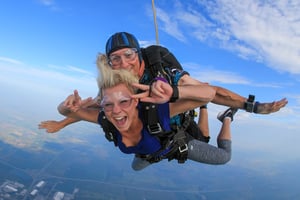
Some excited jumpers show up to the drop zone with the grand idea that they can descend alongside their buddies. However, it would be extremely dangerous to allow two inexperienced, first-time freefallers to jump, tied together, up to 18,000 feet above ground level— and hope they know how to deploy their main parachute. What could go wrong right?
That’s why tandem skydiving involves 1.) a first-time or unlicensed jumper— like you— and 2.) a certified instructor. This professional skydiver needs to have made at least 500 jumps (wow! talk about a lot of drops) and be formally certified by the United States Parachute Association (USPA).
These certified instructors have properly trained for emergency circumstances and have devoted the time and experience necessary to perfect the freefall, and to introduce others to this amazing sport.
But what exactly do these freefall masters do to prepare for their dives? Let’s find out.
Jumping out of an airplane can frighten even the bravest thrill-seeker, but many first-time skydivers take comfort in learning more about their tandem instructor’s expertise and safety procedures.
To become a certified instructor, your freefall partner must go through rigorous jump schooling and have a legitimate level D skydiving license. But what does that really mean?
While a jumper can be considered a certified skydiver and jump solo with a preliminary license— called a level A skydiving license— skydiving is a skill that evolves with continued learning and practice.
That’s why the USPA issues four “tiered” skydiving licenses, from levels A through D, indicating the skill and accomplishment level of each diver.
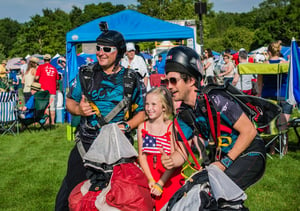
Let’s look at the difference between a newly certified skydiver and an instructor:
An A-license skydiver needs just 25 jumps under their belt, as few as three with a tandem partner. B-license skydivers must pass a written USPA exam, have water landing training and freefall for at least 30 minutes (among other requirements).
The challenges become harder and more disciplined, up through level D skydivers, which are considered “Expert Jumpers.” These expert freefallers have earned all previous licensing and made at least 500 reported jumps, including three hours of freefall time. They’ve also made nighttime jumps and passed the last and hardest of the parachute school’s written exams.
Before your first jump, inquire about your jumping professional’s license type, number of freefalls and years of experience. While C-level skydivers are eligible to get their USPA instructor rating— and can teach you how to prepare for the plunge— they are not certified to perform tandem freefalls.
Although it would be illegal for an A through C-licenced individual to perform a tandem dive with you, it’s always best to confirm and do your research to see if your partner is a true instructor.
Many first-time skydivers wonder if there’s a weight limit for tandem dives. There are indeed weight restrictions, as it can be unsafe for excessively heavy individuals and their instructor to perform freefalls.
Most skydiving centers have a weight limit of approximately 200-220 pounds for women and 230-250 pounds for men during tandem dives. However, this range will vary depending on the center you choose.
But why is there a weight limit in the first place?
Skydiving equipment manufacturers are the ones responsible for setting the weight limits on their products.
These equipment providers put all components of their skydiving gear and the final rig design through rigorous testing, as well as receive a Technical Standard Order (TSO) from the Federal Aviation Administration.
All of this testing is to ensure the gear doesn’t break under pressure and is secure during freefall. Some heavier individuals might threaten the weight limits of the industry-standard gear. Additionally, strap lengths need to be able to extend fully and safely around the jumpers, and large individuals might not have the extension reach necessary to be properly locked in.
Finally, weight restrictions are important because not all instructors can have the physical strength needed to “flare” the parachute (a maneuver essential to landing) and to land safely with a heavier passenger attached.
Simply put, some heavier individuals don’t have the body type or strength to make landing safely possible. Right before landing, the tandem jumper must be able to lift their legs up and hold for 10 seconds, so that the instructor can touch down on the ground first. Some individuals may lack the strength needed to get into or sustain this position.
For the equipment we use at CSC, the total weight of the tandem pair using the system must not exceed 500 pounds. This figure includes the weight of both you, your instructor and your combined gear.
Here at Chicagoland Skydiving Center, we’ve made a chart to display safe weight ranges:
 Some skydive centers are willing to exceed manufacture and USPA recommendations to make more money— but at Chicagoland Skydiving Center, we take weight limitations very serious to protect the safety of both you and our instructors. In fact, we buy new equipment every 36 months, well before industry recommendations, just so that our jumpers and team are the safest in the business.
Some skydive centers are willing to exceed manufacture and USPA recommendations to make more money— but at Chicagoland Skydiving Center, we take weight limitations very serious to protect the safety of both you and our instructors. In fact, we buy new equipment every 36 months, well before industry recommendations, just so that our jumpers and team are the safest in the business. It’s because of this level of care that we’ve had such stellar safety records year after year. We typically drop 35,000+ jumpers a year, all without injury.
Even the best prepared jumpers are no match for turbulent weather. That’s why it’s important to follow all USPA and FAA regulations for weather warnings while skydiving.
There’s a few things to look out for before jumping:
How windy is too windy? Winds that exceed 25 miles per hour or which are gusty and irregular are not good for skydiving.
A skydiving center should touch base with you to reschedule your freefall experience if wind patterns aren’t ideal, but it doesn’t hurt to check yourself and ask to reschedule, if you feel uncomfortable with conditions.
If the forecast is calling for rain the day of your dive, contact your drop-zone to see if they still plan to conduct operations. Light rain might not seem bad, however, during a 120 mile per hour freefall, those tiny droplets can hurt.
Excessive cloud coverage can hinder your instructor’s line of sight. Skydivers are required to follow the Federal Aviation Administration’s Visual Flight Rules (VFR) at all times, and poor vision can cause tandem partners to land miles off course.
Be sure to contact your skydiving center to check about cloud coverage. While your local weather channel may call for clouds, sometimes a front can roll through, or the cloud layer is high enough above your exit altitude to jump without interruption.
Although securing your equipment is ultimately your instructor’s responsibility with any tandem jump, we want you to at least have an understanding of how the rig functions.
In preparation for the big jump, you’ll be fitted into a full body harness. This harness has four connection points on the back, which sit at your shoulders and hips.
They’re located on your back so that they can attach to the front of your instructor’s harness and the tandem parachute system, which the instructor will wear on their back.
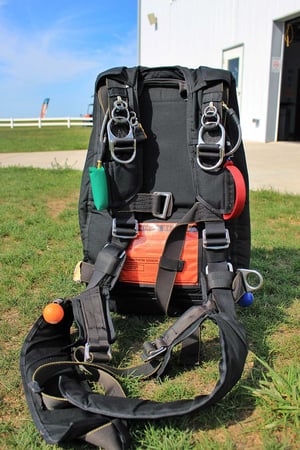
Before the jump, you will be fitted into your harness by your instructor. This removes a lot of the pressure from you, knowing you won’t have to deal with complicated skydiving equipment.
Here at Chicagoland Skydiving Center, we only invest in best harnesses, made by United Parachute Technologies. In addition to trusting this reputable brand, you’ll also never find any rig older than three years old on our rack. (For perspective, most dropzones will use gear for 15-20+ years before retiring the equipment).
Why do we switch our gear out so much more frequently? We value keeping our rigs in top-performing condition to protect our jumping family and new friends, like you. We replace a third of our fleet at a time, annually, and sell off our used items to keep rotating in new rigs at all times.
You’re not plunging to the earth without a well-equipped parachute container (that’s the backpack-like bundle on your instructor’s back that holds your shoots and other equipment).
This bag is secured snuggly to your instructor, but what’s inside?
That’s right, you’re going to be equipped with not one, but three parachutes during your tandem jump!
The first is a little guy called the Drogue. This chute will inflate right after you jump, to help slow down your descent rate and keep you and your instructor in the right orientation: belly-to-ground and limit your freefall speed to around 120mph. This important parachute also helps to deploy the main parachute when it’s time to pull the ripcord.
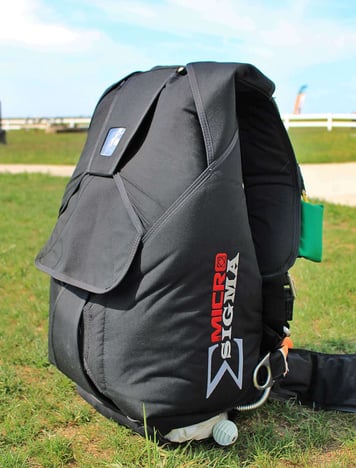
Once you hit 5,000 feet above ground, it’s time to deploy the big papa chute. Your main parachute is the large rectangular canopy that helps you get grounded. It’s always packed by a certified professional to ensure its proper deployment.
Every tandem skydiving system is also equipped with a reserve parachute. This back-up canopy is just like the main parachute, just waiting in the wings. Reserves must be inspected and repacked every 180 days by an FAA certified parachute rigger to ensure they are safe as can be.
At Chicagoland Skydiving Center, we trust Performance Designs for our main and reserve parachutes, for their quality and reputation for excellence.
Let’s say that your tandem instructor loses consciousness on the way down (though the chances are very slim)— and you completely forget everything you learned in your pre-jump class (also, extremely unlikely).
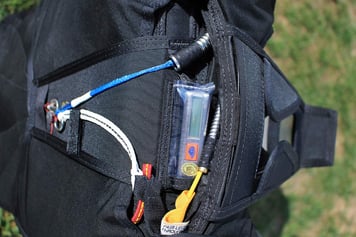
Your parachute system is equipped with a safety device called an Automatic Activation Device (AAD), which monitors your altitude and rate of descent. At a set altitude, the AAD will automatically deploy your reserve parachute on its own. This backup system is just another layer of protection, promising you a safe tandem jump every time.

There are a number of ways you can gear up for your first tandem skydive experience. Let’s look at what you do the day of the jump— during the climb to altitude, freefall and the big landing— to make the most out of your adventure.
As mentioned previously, if the weather is an issue, your skydiving center should call you the day prior to your tandem jump to reschedule. Or, you can give them a call yourself to check conditions.
Unlike the weather, which is out of your control, there’s a few things you can do to prepare for your thrilling plunge:
Some skydivers think that if they eat, they’ll get nauseous or sick during the freefall. However, most first-time skydivers feel better if they maintain their normal eating and drinking schedule. You’ll be less likely to feel light-headed in the air too if properly hydrated.
Please do not consume alcohol prior to your jump to “calm your nerves” or show up for your jump hungover. That right there is a recipe for nausea!
Arrive on Time
Skydiving is already a jittery experience for most first-time jumpers. Don’t add more stress onto your load by rushing to make your appointment.
You’ll have to check-in, fill out paperwork and take a pre-jump orientation before ascending, so give yourself plenty of wiggle room to take care of business before the fun starts.
There’s not a whole lot you need to bring to the big jump. Really all you’ll need is your driver’s license or other government-issued ID, a hair tie (if you have long hair) and jump-friendly clothing.
Though it might seem like a good idea to layer up to avoid being cold, you’ll find that many jumpers wear what they would otherwise wear on ground, or their typical athletic attire.
Although you don’t need to layer up, stick to a tight-fitted wardrobe to avoid bunching materials. It gets pretty windy on your freefall, and flowy clothing can distract from the experience.
You will be required to leave your phone, wallet or other personal items on the ground for the jump too. You don’t want to lose your valuables from 14,000 feet in the air!
On the plane ride up, you’ll likely be feeling some nerves.
Here’s a few things to know about your ascent to prepare for the thrilling freefall:
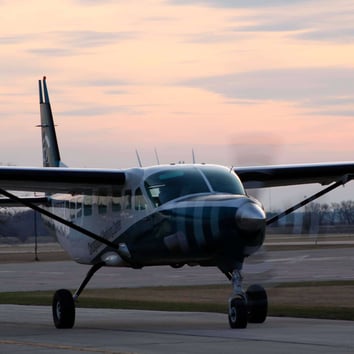 On your plane ride up at Chicagoland Skydiving Center, you may be sharing the space with up to 23 people. Please be respectful of your fellow jumpers and try your best to relax!
On your plane ride up at Chicagoland Skydiving Center, you may be sharing the space with up to 23 people. Please be respectful of your fellow jumpers and try your best to relax!
Many others around you are probably first-time jumpers themselves, and keeping a positive mood builds energy throughout the plane. Some people like to use the ride to meditate and calm their heart rate, while social butterflies find comfort in chatting with their neighbor to pass the time.
Whatever you do, regulate your breathing and smile. It’s natural to be a little anxious, but all your worries will soon transform into a wild, exciting rush!
Fun fact: While only about two dozen people are along for the ride, we have the capacity to drop up to 150 people an hour.
First-time jumpers will likely be surprised by how little they have to worry about during the tandem skydiving experience.
Your certified tandem instructor will be pulling the ropes (both literally and metaphorically). All you really have to do is focus on your body position. Remember to arch your body during the freefall, so that your belly is jutting out towards the ground.
The fall itself will feel a lot more like flying than falling, since you’ll have the support of your small drogue parachute the whole way down.
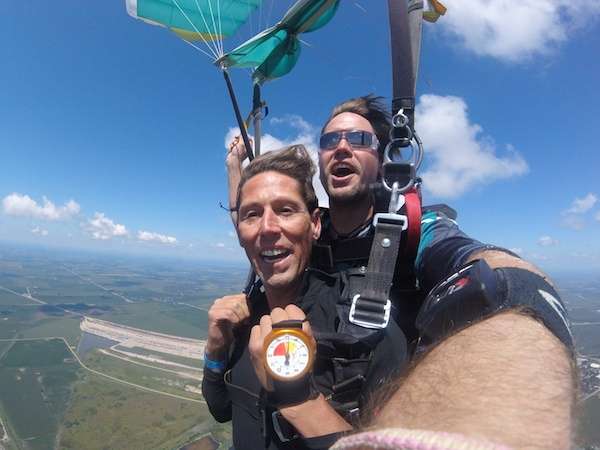 If you read our safety section above, then you already understand that you must raise your legs to help your instructor land the two of you smoothly. That’s because the instructor has to be the first to touch ground to properly absorb the impact, whether that be with their feet in a standing position, or sliding in on their behind.
If you read our safety section above, then you already understand that you must raise your legs to help your instructor land the two of you smoothly. That’s because the instructor has to be the first to touch ground to properly absorb the impact, whether that be with their feet in a standing position, or sliding in on their behind.
Keeping your legs out of the way ensures you won’t be harmed, and that your instructor can get you down safely. You trying to land yourself can lead to injury to your ankles, or worse, if you topple the two of you over.
We’ve got a few pieces of advice for first-time tandem skydivers— straight from the experts themselves:
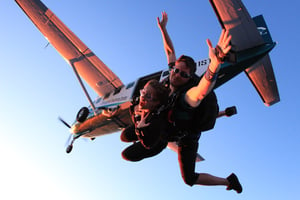 You want proof of your wild dive, don’t you? You’re not exactly going to be able to freefall with a selfie-stick (well, you could, but you sure won’t land with it!).
You want proof of your wild dive, don’t you? You’re not exactly going to be able to freefall with a selfie-stick (well, you could, but you sure won’t land with it!).
That’s why we have professional photographers and videographers diving right alongside you— to capture the thrill.
A more cost-effective option is having your instructor take video and still photos from a sport camera mounted on a specially designed freefall glove. The cameras look back at both of you and give an amazing selfie-style shot that is worth the investment.
We highly recommend having someone capture this exciting experience. You’ll have high quality footage and imagery to show off on social media, and to remember your jump for many years to come.
It’s tempting to shut your eyes nice and tight on your “scary” freefall. But seeing the wonder amongst the clouds is one of the best parts!
Remember, your tandem instructor has done these leaps near countless times. Just to get their tandem licensing alone, they had to complete at least 500 jumps.
Reread the section above on tandem instructor requirements to remind yourself that these guys are the experts— and that you’re in trusted hands.
Everyone’s got some nerves during their first tandem jump. But what a thrill it is! Embrace the butterflies in your stomach and live a little.
It’s going to go a lot faster than you think, so revel in the moment.
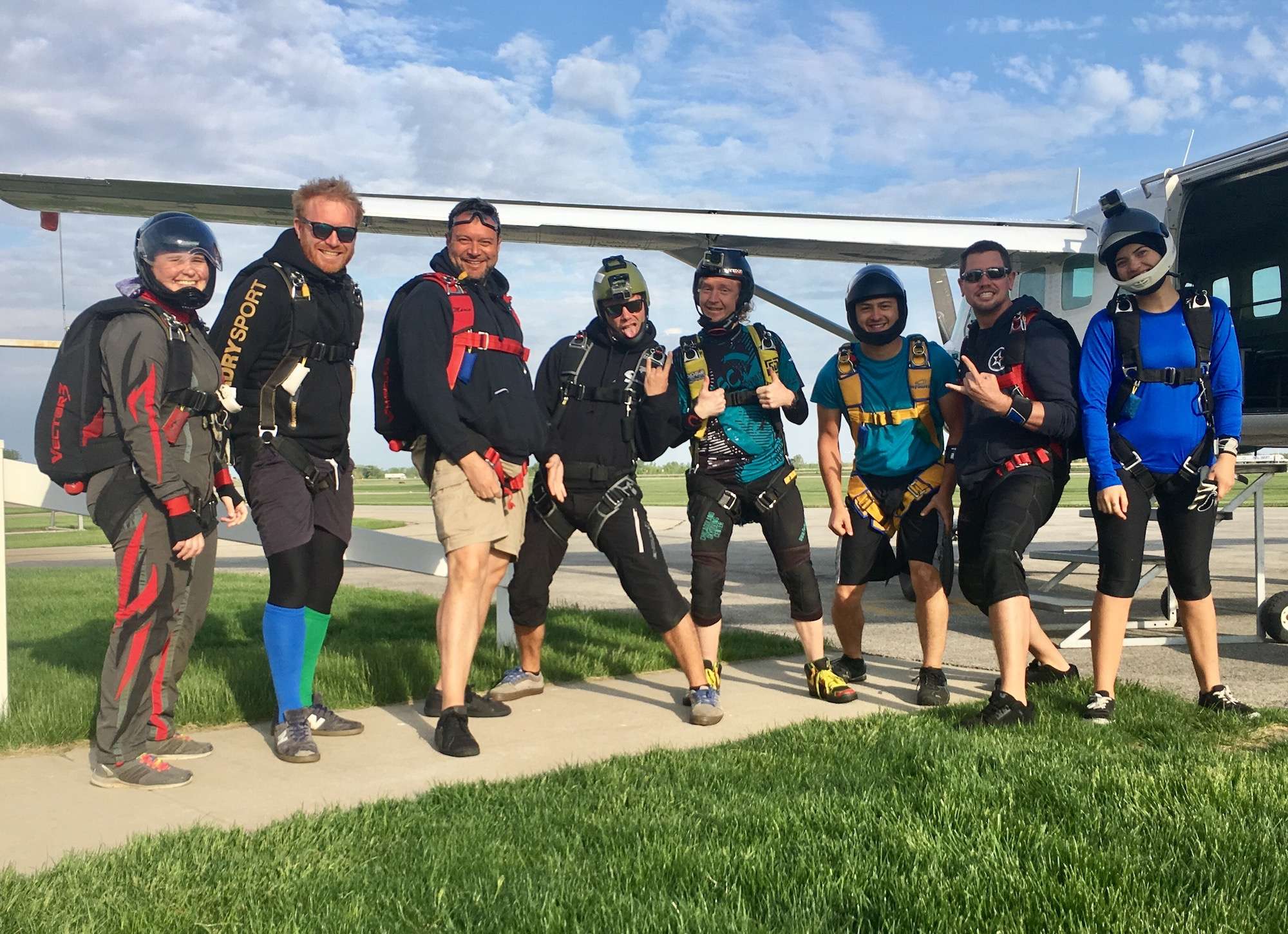 Skydiving only gets better the more times you do it. Not only are you prepared for how it goes, but your nerves will often settle with each jump— giving you all the more clarity to take in your stunning aerial surroundings
Skydiving only gets better the more times you do it. Not only are you prepared for how it goes, but your nerves will often settle with each jump— giving you all the more clarity to take in your stunning aerial surroundings
Here at CSC, we offer great second jump specials. Share the thrill with your buddies and bring a different group of friends for round two. Did we mention that if you bring in 10 guest jumpers, you get a jump on us— absolutely free?
You’ve got tandem skydiving questions for us at Chicagoland Skydiving Center— and we’ve got answers.
Here are some frequently asked questions about your freefall experience:
How old do you have to be to skydive?
In the U.S., jumpers must be 18 years or older— no exceptions! You will be asked to provide ID with your date of birth, upon check-in on the day of your reservation.
Minimum age requirements are in place because minors are not able to sign legal documents, and parents and/or legal guardians are not legally allowed to sign away a minor’s rights.
Be cautious of skydiving centers that allow minors to skydive, even with parental consent.
Is there a weight limit for skydiving?
Yes. The most important factor is that your height and weight are proportionate*, to allow for proper fit of the equipment. In addition, you must weigh no more than 240 pounds.
Weight limits are strictly enforced and everyone is weighed prior to jumping. Every parachute system has a maximum weight it is rated to carry in order to function properly and safely.
CSC uses the best tandem skydiving equipment available and adheres to all manufacturer recommendations for use. Read our blog to learn more: Why is there a skydiving weight limit?
*Proportionate body type means your weight is more or less evenly distributed throughout your body. Please reference the chart on this page to see where you fit. If you have questions for your specific case, please contact our customer care team before making your reservation.
How long does the freefall last?
The length of a jump depends a lot on the type of aircraft, exit altitude, body weight and surface area.
At Chicagoland Skydiving Center, you’ll spend 10-15 minutes in the airplane, climbing to exit altitude*.
Exit altitudes:
TIP: When deciding where you want to skydive, you should ask the dropzone how long the airplane ride will take and what altitude you will jump from. You could be paying the same price to sit in a plane for 30 minutes and jump out at 10,000 ft or jump at CSC and be in the plane 15 minutes and jump from 14,000 ft. You should get every bit of altitude you pay for!
*This is only true for our fast turbine aircraft. Other dropzones who operate small single engine planes typically take 20-30 minutes to climb to exit altitude.
Is breathing difficult when falling?
Some people tend to hold their breath when they feel nervous or get a sudden rush of adrenaline. You just have to remember to inhale and exhale; the air is all around you!
Sometimes we tell students to scream if they feel like they can't breathe. This action forces you to exhale and then inhale again when you're done. Then you can go back to smiling.
Can I bring my GoPro camera on my tandem skydive?
When you make a tandem skydive, you are considered a student skydiver. Per the rules of the United States Parachute Association, student skydivers cannot jump with any kind of video or photography equipment.
For the safety of you and your instructor, unlicensed skydivers will not be permitted to bring along a camera, even a small format sports camera.
Your instructor or videographer may use these tools to record your jump for you. Be assured that these are professional skydivers trained to use these cameras while also maintaining the proper safety procedures.
What should I wear to skydive?
Dress for the weather that day, in comfortable pants, shorts or athletic wear. If it's hot, a T-shirt is just fine. If it's cold, a sweater or sweatshirt is best. If the sun is shining, it never hurts to wear sunscreen. Ladies, bring a hair tie!
Please wear sneakers, or shoes that you know will stay on your feet. No sandals or open toe shoes will be allowed for tandem or freefall University students. Please avoid boots or any shoes with large buckles or lace hooks.
We will provide a jumpsuit, goggles, altimeter and gloves (if it's cold) for your jump.
Please plan to leave valuables like phones, wallets, watches and jewelry in your car. We can hold your keys and hats for you on the ground during the jump. Don't jump with anything in your pockets you wouldn’t want to lose!
What is CSC's rescheduling and refund policy?
We have a flexible rescheduling policy, but we do ask that you give us at least 48 hours notice. We know you’re busy and we want every part of your experience to be amazing.
If CSC must reschedule your appointment due to weather, your jump price is valid for one year from original appointment date. Guests who wait longer than one year to use jump reservation will be responsible for any difference in cost for the current retail price of their booked service.
Can I back out on the plane if I chicken out?
We’re not going to strap you to your partner and force you to jump! Should you decide on the ascent that you can’t go through with the exciting freefall, you can wait on the plane until we land. However, you will be charged a fee for your tandem skydiver’s time.
How far in advance should I plan and book my skydive?
Really, the sooner the better! Slots fill up fast, because people love diving with us at CSC!
We have the capacity to drop up to 150 people an hour, but we can’t always accommodate walk-ins. Reserve your spot today to guarantee availability.
How fast will I fall?
Super fast! But really, it’s more like up to 120 miles per hour.
Your tandem instructor will keep you in a belly-to-earth position, which keeps your velocity consistent. You won’t “gain speed” as you descend, thanks to your drogue parachute, which is released soon after the jump.
Can I do a solo jump for my first jump?
Nope. First-time skydivers descend with a trusted tandem instructor, who has made a minimum of 500 jumps and is a certified instructor. Safety is key, and these guys have the knowledge and experience needed to get you to the ground in one piece
If you are serious about diving solo, you’ll have to go through training and take formal skydiving schooling. Don’t be afraid to ask us more about how to get involved in our freefall University Skydiving School after your tandem dive to become a United States Parachute Association certified skydiver.
How much does skydiving cost?
The price of your skydiving experience will vary based on how long you’d like to be in the air and how far you’d like to fall from.
Our 9,000 foot jump package, for 30 seconds of freefall, is currently $149.99 a person, while our 14,000 foot / 60 seconds jump is $199.99. Please review our pricing page for details on the cost of your tandem dive, as rates are subject to change.
Can my friends jump with me?
Yes! Your friends can join you on the skydiving experience, however, they will not be the one strapped to you. You will descend with an instructor as your tandem partner.
While your buddies can ride up on the plane ride with you, you will not jump simultaneously, for safety reasons. Our skydiving professionals allow jumps at precise intervals to ensure your friends can land securely before or after your freefall.
Jumping with your friends is a great way to get group rate discounts, and our facilities and Flight Deck Bar & Grill are popular spots for parties or events.
Do I need any equipment for tandem skydiving?
You do not need to own any special skydiving gear to enjoy a tandem freefall. The skydiving center will provide you with a properly fitted harness and the parachute system that you’ll need, as well as other gear like goggles, gloves, jumpsuit, etc.
What altitude do we open the parachute?
Right after you exit the aircraft, a small parachute called the drogue will inflate. This small parachute helps to slow you down and to keep you and your instructor belly-to-earth. It also helps to release the main canopy when it’s time to pull the ripcord.
Once you reach 5,000 feet above ground, it’s time to deploy the main parachute. This is the big canopy that helps you land. If for some reason this canopy fails to deploy properly (very rare!), your reserve canopy will automatically deploy at a preset altitude to ensure you land safely.
How difficult is landing? Will it be hard on my legs?
The landing is something that many first-time skydivers fear, but as a tandem skydiver, you don’t have to worry. Your instructor will be the one to touch the ground first, absorbing the impact, skillfully, in a standing position or by sliding in on their back.
Your only role is to raise your legs up and keep them out of your instructor’s way. This will require you to raise your legs up as if you were in an invisible chair, for roughly 10 seconds.
This can be difficult for some individuals. Please refer to our detailed explanation of weight limits above.
Will my ears pop on the way down?
If you’re the type of person whose ears pop on airplanes, you may notice similar pressure during the descent.
Skydiving can be quite loud, from the roar of the plane engine to the rush of wind during the freefall. That’s why many first-time skydivers find it helpful to wear earplugs, which can help to protect your ears from uncomfortable noise volume.
If you are sick and experience ear blockage or sinus issues, we recommend you reschedule your skydive. This congestion can block your eustachian tubes, which decreases your tubes’ ability to regulate ear pressure. You don’t want to burst or puncture an eardrum on the descent, so it’s better to not risk it.
Can my friends / family watch?
Of course they can! With our open air design and the Flight Deck Bar & Grill, anyone can get a taste of the action, without ever having to jump. This patio is also a favorite spot for eating, planning parties or for hosting exciting events.
Our Sigma Skydeck is also a great place to relax with a drink and watch our happy skydivers descend.
How much prep or training do I need before I jump?
Fortunately, you don’t have to go through a lot of “schooling” to be a tag-along on a tandem skydive (though your instructor and instructor sure had to!).
To get ready for your jump, you’ll watch an orientation video and have a briefing with your instructor. You’ll learn all about the parachute system and safety precautions during this time, and discover that most of the “hard” work is done by your instructor!
After you learn about the freefall, we’ll get you in a jumpsuit, harness, altimeter (to monitor your altitude) and goggles— and get ready to board the aircraft!
What type of airplane do I jump out of?
Chicagoland Skydiving Center owns and operates some of the best aircraft in the industry. In fact, the award-winning fleet has received praise from a number of professional sources, including the Blue Skies Magazine’s “Best in the Business” title.
These planes aren’t just used for skydiving, they’re also rented for military airborne operations training, aerial cinematography and media event coverage. Learn more about our fleet here.
How do I tell a good dropzone or skydiving center from a bad one?
Look to see if a skydiving center puts an emphasis on safety— and not just says that they do!
Take a close look at their policies. For example, some skydiving centers let those below the age of 18 do a tandem dive!
Check how frequently they replace or check their equipment. Most dropzones will use gear for 15-20+ years before retiring the equipment. Here at Chicagoland Skydiving Center, we only invest in the best parachute systems, made by United Parachute Technologies, and replace ⅓ of our feet annually— because safety is paramount.
Don’t be afraid to search for reviews as well, or if they were mentioned in the press. Testimonials tell a lot about a company, and you’ll quickly notice online if customers aren’t satisfied with their jumps.
Now that you’ve learned all about tandem skydiving, are you ready to take your first plunge?
Slots fill up fast, so don’t wait to book your freefall!